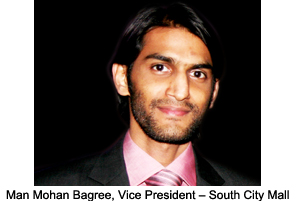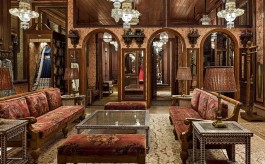Home » Viewpoints » Gung-ho on East
Gung-ho on East
By Nabamita Chatterjee | November 21, 2013
With Indian retail market growing at a very fast pace, the East is fast catching up joining the'brandwagon', thanks also to the new and rapidly spreading mall culture. VM&RD chats up with Man Mohan Bagree, Vice President - South City Mall which has become the modern landmark for the youth, retailers and consumers of Kolkata, to know more about the brand's plans for the Eastern market.
 What is your outlook on retail, especially in the context of Eastern India for the year 2013-14?
What is your outlook on retail, especially in the context of Eastern India for the year 2013-14?Retail, being the future, has been the biggest emerging industry in the last couple of years and is considered to be the most promising and supporting economy to India. If we consider the first two quarters of this financial year, it was stable but the last quarter seems to be more positive and the growth has been really good during this festive season showing an excellent path to retailers in Eastern India as it celebrated festivals like Durga Puja, Diwali and Eid. We feel that the financial year would end with more profitable figures as against previous YoY with Christmas and New Year round the corner.
Can you share the success journey of South City which has emerged as the most happening Mall of Kolkata?
When South City was conceptualised, it was a very challenging project for the retail industry in India. It was launched in January 2008 at the heart of the city and at that time it was one of the largest malls of the country. South City practically introduced the culture of organised shopping in East and till date it competes with some of the biggest malls in India. Thus it actually set the benchmark to other developers who later entered the mall market in this zone. The journey so far has really been exciting, challenging. We created the country's first anchor driven mall where brands like largest Shopper's Stop, Pantaloons, Spencer's Hypermarket, Food Court, the largest Entertainment Zone spread over an area of 1 million sq. ft. are all present, and to maintain the image we have created, we have evolved with time making this a favoured destination for all in the city and the travellers coming here as well.
How do you deal with increasing consumer demand for international brands, especially in the context of East India?
International brands represent the aspirational value for Indians. Thus it is excellent that with the entry of these brands, the consumers are aspiring for more and it is pushing the retail industry in a positive direction, acting as a bridge to national brands. We at South City introduced Kolkata to some of the international brands like Marks & Spencer's, Body Shop and such for the first time.
What according to you were the factors that contributed to the changing consumer mindset?
With globalisation the change had to come and with Kolkata being the gateway to the retail of Eastern India, South City provided the right space to retailers who wanted to enter this market and take it to the next level. Today we attract all kinds of consumers and from diverse age groups who find this place appropriate as a shopping destination for them.
In the last few years we have seen many malls coming up and closing down soon. What is your own strategy to survive?
We keep our fundamentals simple. South City is a public mall open to all categories of retailers and we do not try to differentiate ourselves with status like'entry-level' or'luxury mall' as we feel that a mall has to be for mass by default, irrespective of whether a consumer or a retailer belongs to an entry level or is a high-end buyer. For example, we try to cater to a customer and pamper him even if he/she is coming to enjoy a coke at the food court or is shopping for hours. We maintain the same level of hospitality for all which makes us different from other mall developers.
What kind of strategies has South City adopted to surpass the consumer expectations and being the most celebrated mall of the East Zone?
For us, it is the over-all experience that we try to give to our consumers and maintaining that'hospitality for consumers' approach plays the biggest role which helps us to surpass customer expectations. We want to establish the fact that even if you do not shop it is a destination for you and your family where you may spend quality time. We ensure that all our retailers get equal exposure and when it comes to providing customers the best retail ambience in the East Zone, we do not compromise at any cost. Here we cater to each segment. Whether it a daily groceries purchase, an air ticket purchase or a purchase for a big family function, one will get every item under a single roof.
Can you share the possibilities that East offers as an emerging big retail market?
East no doubt has great potential and is a growing market which is still untapped in many ways. It will gradually grow within a year and a half and new retailers are already coming here because they have understood that there is huge scope for development here unlike in cities in other regions, which have become saturated. In fact, some of the chains have already closed down their shops in places like Bangalore, Mumbai etc.
What is your message to aspiring retailers who want to invest here in East? Do you think the tier II and tier III cities are better options for them?
There are two aspects to that. First, for retailers, there is definitely a huge potential here and they should explore the opportunities and employ the right strategy here. For example, we try to influence the customers with lot of promotions, making them aware and updated on the options available, and this triggers impulse buying.
Secondly, in the case of developers, they should have the right mix of brands and ambience that are needed for the particular zone they want to cater to.
I feel Tier II and Tier II cities are far better options to explore compared to metros, both for developers and retailers. we are also trying to promote it in international retail forums by putting forward the view that customers over there should be upgraded and catered to through entry level brands and national brands and having an organised retail atmosphere with MBO's or EBO's. Cities like Jamshedpur, Ranchi, Patna, Bhubaneswar and Guwahati have great potential and development should have the right mix there.
What is your take on the recent FDI policy and what do you think would be its effect on Indian Retailers?
It is still in its pre-mature stage and lot of clarity is required, though I feel the international brands would go for joint-ventures with Indian retailers and will not be 100% open because the policies till date are not well defined. But yes, the entry of foreign brands will compliment the Indian retail scenario. Thus, I do not see the FDI affecting the retail scene in any negative manner. New brands mean healthier competition, which is always welcome, as today the customers are all informed buyers and know where to go for their shopping.
Advertisement
Related Viewpoints
Advertisement









Comments